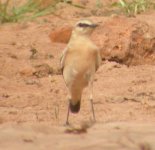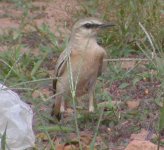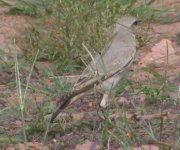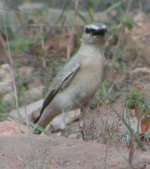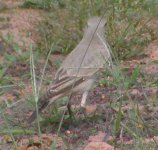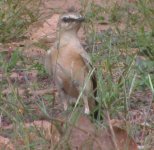Anyone got any opinions on this Wheatear? Pics taken in Central African Republic on Sunday.....
-
Welcome to BirdForum, the internet's largest birding community with thousands of members from all over the world. The forums are dedicated to wild birds, birding, binoculars and equipment and all that goes with it.
Please register for an account to take part in the discussions in the forum, post your pictures in the gallery and more.
You are using an out of date browser. It may not display this or other websites correctly.
You should upgrade or use an alternative browser.
You should upgrade or use an alternative browser.
Wheatear - Central African Republic (1 Viewer)
- Thread starter dendroica
- Start date
More options
Who Replied?JWN Andrewes
Poor Judge of Pasta.
Hi Mike
don't know if there are any confusion species out there but it looks like Isabelline to me - very upright, black loral stripe, sandy fringes to coverts, that's certainly the direction I'd be thinking if I encountered this in UK (fat chance!)
James
don't know if there are any confusion species out there but it looks like Isabelline to me - very upright, black loral stripe, sandy fringes to coverts, that's certainly the direction I'd be thinking if I encountered this in UK (fat chance!)
James
Jane Turner
Well-known member
I thought it might be an Isabelline on the head on view - but I don't like the wings. So current best guess is Northern Wheatear. I need to look longer and harder - or ideally let someone else do it.
Thanks for the quick replies. My first thought was also Isabelline Wheatear. However, I've no idea if there are any confusion species in this area (and don't have the relevant books to check). I'm also unsure as to how good a record this would be (Isabelline) as I've no info on the wintering range. Has anyone got suitable literature to check?
Mike
Mike
JWN Andrewes
Poor Judge of Pasta.
Not to hand Mike but saw a few in Kenya last November so they certainly get sufficiently far south - will check a book or two when I pop home at lunchtime, so if no one's chipped in with the gen by then I shall do so.
James
James
Jane Turner
Well-known member
From BWP
Winters up to northern edge of Sahel zone in West Africa, as far west as south-west Mauritania and northern Sénégal. Common in Mali between 13½° and 17°N and the commonest Oenanthe there north of 16°N (Lamarche 1981; see also Bates 1933–4). Winter distribution in central West Africa may be discontinuous (Moreau 1972); though regular in Chad, rare west of 19°E (Newby 1980). Winters in some areas of Egypt (Goodman and Ames 1983) and common in Sudan (Cave and Macdonald 1955); abundant in Ethiopia (Ash 1980), including Eritrea (Smith 1957), and in Somalia (Ash and Miskell 1983). Occurs regularly in north-east Zaïre (Lippens and Wille 1976; Curry-Lindahl 1981). Common in Kenya, eastern Uganda, and northern Tanzania, but very occasional in southern and western Uganda; few records south of 4°S in Tanzania (Britton 1980). 3 records in northern Zambia (Aspinwall 1977). Generally rather common through Arabia (e.g. Jennings 1981a). Recorded mid-January at Azraq, Jordan (Conder 1981), and in December and early January in Syria (Macfarlane 1978). Widely distributed winter visitor in Mesopotamia, Iraq (Allouse 1953); uncommon in lowland Iran (Cornwallis 1975). In some years, a few (mainly ♂♂) winter in southern Turkmeniya (USSR) at c.*40°N (Bel'skaya 1965a; Panow 1974), though Turkmeniyan population wholly migratory according to Ivanitski (Ivanitski 1981c); for earlier detailed discussion, see Rustamov 1954. Fairly common in Pakistan and north-west India in winter (Ali and Ripley 1973b). Winters up to northern edge of Sahel zone in West Africa, as far west as south-west Mauritania and northern Sénégal. Common in Mali between 13½° and 17°N and the commonest Oenanthe there north of 16°N (Lamarche 1981; see also Bates 1933–4). Winter distribution in central West Africa may be discontinuous (Moreau 1972); though regular in Chad, rare west of 19°E (Newby 1980). Winters in some areas of Egypt (Goodman and Ames 1983) and common in Sudan (Cave and Macdonald 1955); abundant in Ethiopia (Ash 1980), including Eritrea (Smith 1957), and in Somalia (Ash and Miskell 1983). Occurs regularly in north-east Zaïre (Lippens and Wille 1976; Curry-Lindahl 1981). Common in Kenya, eastern Uganda, and northern Tanzania, but very occasional in southern and western Uganda; few records south of 4°S in Tanzania (Britton 1980). 3 records in northern Zambia (Aspinwall 1977). Generally rather common through Arabia (e.g. Jennings 1981a). Recorded mid-January at Azraq, Jordan (Conder 1981), and in December and early January in Syria (Macfarlane 1978). Widely distributed winter visitor in Mesopotamia, Iraq (Allouse 1953); uncommon in lowland Iran (Cornwallis 1975). In some years, a few (mainly ♂♂) winter in southern Turkmeniya (USSR) at c.*40°N (Bel'skaya 1965a; Panow 1974), though Turkmeniyan population wholly migratory according to Ivanitski (Ivanitski 1981c); for earlier detailed discussion, see Rustamov 1954. Fairly common in Pakistan and north-west India in winter (Ali and Ripley 1973b).
Agree it looks shape wise very like an Issy - still need to check out the wings.
Winters up to northern edge of Sahel zone in West Africa, as far west as south-west Mauritania and northern Sénégal. Common in Mali between 13½° and 17°N and the commonest Oenanthe there north of 16°N (Lamarche 1981; see also Bates 1933–4). Winter distribution in central West Africa may be discontinuous (Moreau 1972); though regular in Chad, rare west of 19°E (Newby 1980). Winters in some areas of Egypt (Goodman and Ames 1983) and common in Sudan (Cave and Macdonald 1955); abundant in Ethiopia (Ash 1980), including Eritrea (Smith 1957), and in Somalia (Ash and Miskell 1983). Occurs regularly in north-east Zaïre (Lippens and Wille 1976; Curry-Lindahl 1981). Common in Kenya, eastern Uganda, and northern Tanzania, but very occasional in southern and western Uganda; few records south of 4°S in Tanzania (Britton 1980). 3 records in northern Zambia (Aspinwall 1977). Generally rather common through Arabia (e.g. Jennings 1981a). Recorded mid-January at Azraq, Jordan (Conder 1981), and in December and early January in Syria (Macfarlane 1978). Widely distributed winter visitor in Mesopotamia, Iraq (Allouse 1953); uncommon in lowland Iran (Cornwallis 1975). In some years, a few (mainly ♂♂) winter in southern Turkmeniya (USSR) at c.*40°N (Bel'skaya 1965a; Panow 1974), though Turkmeniyan population wholly migratory according to Ivanitski (Ivanitski 1981c); for earlier detailed discussion, see Rustamov 1954. Fairly common in Pakistan and north-west India in winter (Ali and Ripley 1973b). Winters up to northern edge of Sahel zone in West Africa, as far west as south-west Mauritania and northern Sénégal. Common in Mali between 13½° and 17°N and the commonest Oenanthe there north of 16°N (Lamarche 1981; see also Bates 1933–4). Winter distribution in central West Africa may be discontinuous (Moreau 1972); though regular in Chad, rare west of 19°E (Newby 1980). Winters in some areas of Egypt (Goodman and Ames 1983) and common in Sudan (Cave and Macdonald 1955); abundant in Ethiopia (Ash 1980), including Eritrea (Smith 1957), and in Somalia (Ash and Miskell 1983). Occurs regularly in north-east Zaïre (Lippens and Wille 1976; Curry-Lindahl 1981). Common in Kenya, eastern Uganda, and northern Tanzania, but very occasional in southern and western Uganda; few records south of 4°S in Tanzania (Britton 1980). 3 records in northern Zambia (Aspinwall 1977). Generally rather common through Arabia (e.g. Jennings 1981a). Recorded mid-January at Azraq, Jordan (Conder 1981), and in December and early January in Syria (Macfarlane 1978). Widely distributed winter visitor in Mesopotamia, Iraq (Allouse 1953); uncommon in lowland Iran (Cornwallis 1975). In some years, a few (mainly ♂♂) winter in southern Turkmeniya (USSR) at c.*40°N (Bel'skaya 1965a; Panow 1974), though Turkmeniyan population wholly migratory according to Ivanitski (Ivanitski 1981c); for earlier detailed discussion, see Rustamov 1954. Fairly common in Pakistan and north-west India in winter (Ali and Ripley 1973b).
Agree it looks shape wise very like an Issy - still need to check out the wings.
Jane Turner
Well-known member
Looking at the back of that bird it is incredibly worn so its possible that all the pale fringes have worn away - and hence account for the darkness of the tertials, secondaries etc
lou salomon
the birdonist
secondaries are quite dark, but: it has the issy stance. look at those long legs. heavy bill. quite well marked super+lore, plain greybrown in the rest of plumage. looks good for isabelline to me.
Last edited:
hannu
Well-known member
Same kind of features in pic 5 (post 8) as follow Isabelline:
http://www.tarsiger.com/images/linto/Oenisa_041226_Oman_3.jpg
http://www.tarsiger.com/images/linto/Oenisa_041226_Oman_3.jpg
Darrell Clegg
Well-known member
If it is an Isabelline why can't I see any white in the tail or UTCs in any of the photos?
Darrell
Darrell
Darrell Clegg said:If it is an Isabelline why can't I see any white in the tail or UTCs in any of the photos?
Darrell
In pic 4 the UTCs look white - but I agree that they look a little "sandy" in some of the other pics. Likewise, I take your point about there not being any visible white in the tail. However, I would expect Isabelline to show a largely black tail - perhaps the white is obscured in these pics??
Mike
JWN Andrewes
Poor Judge of Pasta.
Sorry Darrell the U in UTCs - upper or under? I guess you mean upper! The only pics you might expect to see it on are the 4th of the first lot and the 1st of the second lot, and yoy're right, it does look buffy rather than white. Dunno why, and I still reckon it'll turn out to be an Izzy. I acknowledge that's a pretty poor response, but it's all I can come up with! As for on the tail itself, again I lack an explanation why it's not visible where you'd expect to see it (esp. pic 3, lot1, along the basal edge), and on the shots showing more or less the whole undertail clear(ish)ly it's hard to tell where undertail coverts end and tail feathers begin, so some of that pale buffy colour towards the end could be attributable to shaded white areas under the retrices, again, I dunno! But you're right, the id would be much more comfortable if these white bits were clearly visible. Any field obs to resolve this Mike?
James
James
JWN Andrewes said:Any field obs to resolve this Mike?
James
Nope - just got sent the pics. I agree that you would expect to see some white on upper tail/rump - on this bird 'appears' "sandy" rather than white (from what we can see). I was assuming that the white was either hidden, or the colouration in pics not true to life (contamination or photographic effect).
Happy to hear if anyone has any opinion on the ID...
lou salomon
the birdonist
tail often looks all dark from above when on ground. in flight the very broad band with few white is usually dinstinctive (but there are exceptions). UTCs indeed look a bit too creamy, but i can't think of anything else than isabelline for this bird (jizz, stance, colour...)
hannu
Well-known member
I would say it's Isabelline, because
1)
the tip of wing reach near middle of the black tail (at least 1/3 of blackish area, thus at least 3 primaries beyond the upper edge of black tail-band) and also tail seems to be quite long, it point out that bird has broad terminal tail-band.
> pics 3,5
2)
supercilium widest and whitish in the front of eye (NW usually widest behind the eye and if partly white, this colour is confined to rear part instead of the opposite) and whitish also above of eye, but rather short, narrower behind eye and tapering off rather pointed at rear. > pics 2,4,6
1)
the tip of wing reach near middle of the black tail (at least 1/3 of blackish area, thus at least 3 primaries beyond the upper edge of black tail-band) and also tail seems to be quite long, it point out that bird has broad terminal tail-band.
> pics 3,5
2)
supercilium widest and whitish in the front of eye (NW usually widest behind the eye and if partly white, this colour is confined to rear part instead of the opposite) and whitish also above of eye, but rather short, narrower behind eye and tapering off rather pointed at rear. > pics 2,4,6
Last edited:
Users who are viewing this thread
Total: 2 (members: 0, guests: 2)




